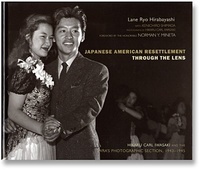I recently picked up a fascinating book, Lane Ryo Hirabayashi’s, Japanese American Resettlement Through the Lens: Hikaru Carl Iwasaki and the WRA’s Photographic Section, 1943-1945. Hirabayashi teaches in the Asian American Studies Department at UCLA, where he holds an endowed chair dedicated to research on and teaching about the Japanese American World War II internment, redress and other Japanese-American issues.
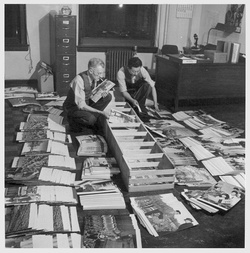
Charles E. Mace and Hikaru Iwasaki of the WRA Photographic Unit -- Denver, Colorado. 2/12/45. National Archives photo. WRA no. G-811
In Through the Lens, which Hirabayashi wrote with researcher Kenichiro Shimada, the authors brings to light the work of Hikaru Carl Iwasaki, a 19-year-old Nisei (second-generation Japanese American) photographer who was plucked out of the Heart Mountain, Wyo. internment camp in 1943 to take a job with the War Relocation Authority’s Denver, Colo.-based Photographic Section (WRAPS). Iwasaki was one of more than 120,000 people of Japanese descent living on the West coast of the U.S. after the bombing of Pearl Harbor in December 1941 who were summarily rounded up and placed in 10 so-called “internment camps.” The role of the civilian War Relocation Authority was to oversee the evacuation and internment, which took place between 1942 and 1945.
WRA photographers meticulously documented this process, both for historical record-keeping and for public relations purposes. All photos were subject to military oversight and those that did not depict the treatment of the Japanese Americans in a positive light were censored.
Hirabayashi divides the WRA’s photo documentation into two phases, first the evacuation and internment, and second the process of resettlement. This second phase began in 1943, the year that Iwasaki was hired. During this period, WRAPS’ goal, Hirabayashi explains, was to pressure “loyal” imprisoned Japanese Americans to return to society as quickly as possible. Although the anti-Japanese hysteria that led to internment had lessened somewhat, prisoners, who in many cases had lost all their possessions and savings, knew they would face hostility and few job options.
WRAPS (which by this time had consolidated its photo operation from scattered locations to the one Denver office where Iwasaki was employed) skillfully combined image and text to create what Hirabayashi calls “photo-narrative public relations packages” designed to convince fearful camp residents that fulfilling educational experiences, satisfying careers and happy roles in American communities awaited those who were brave enough to leave camp and settle in communities far from the still militarily sensitive and largely unwelcoming West coast. At the same, the photos were meant to quell anxiety among the people seeing Japanese former internees move into their neighborhoods, and to show that the decision to evacuate, imprison and then resettle the Japanese Americans had been the correct one.
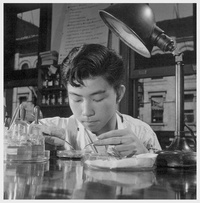
Shin Tanaka. Photographer: Iwasaki, Hikaru -- New York, New York. 8/?/44 National Archives photo. WRA no. 1-402
As a WRAPS staff photographer, Iwasaki traveled through broad swaths of the Midwest and East coast documenting the success stories of Japanese American resettlement. He took over 1,300 pictures for WRAPS before going on to an illustrious career as a photojournalist.
Among his WRAPS photos, we see Kosaku Steven Tamura, described in the caption as a lawyer, a member of the California bar in private practice in Santa Ana, now doing graduate work at Harvard. There is group of fresh-faced college co-eds from the University of Connecticut at Storrs, and Shin Tanaka, a 16-year-old Issei (first-generation Japanese immigrant) and aspiring doctor, working at as a lab assistant at Mt. Sinai hospital in New York City. Tanaka’s father, the photo caption tells us, was educated in the U.S., and held degrees from Duke, Clark, and Yale Universities. Photo captions were not written by the photographer, but by WRA officers.
“Naturally,” Hirabayashi writes, WRAPS did not document stories of Japanese Americans “in difficult or impoverished conditions.” Designed to further the WRA’s goal of resettlement, the photos depict former prisoners as “smiling, happy, free, confident about their safety,” eager to contribute to the war effort through their compliant and successful resettlement.
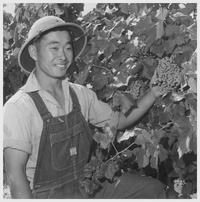
Toshihiro Masada. Photographer: Iwasaki, Hikaru -- Caruthers, California. 6/25/45 National Archives photo. WRA no. I-950
Despite the smiling faces and rosy captions, we get glimpses of the genuine fear that the Japanese Americans must have felt reentering society, and the hostility they faced. Toshihiro Masada grins into the distance as he holds up a beautiful cluster of Thompson seedless grapes. He was released from the Rhower, Ark. camp, and was lucky enough to return to the family’s California farm. The caption reads, “The Masada home was a target of one of the shooting incidents in the Fresno district on the night of May 19, 1945. Five rifle shots were fired into their home, none of which caused any injury or damage. In spite of the incident, the family is glad to be home again.”
George Yamamoto, an Issei farmer who was imprisoned at Gila River in Ariz., is pictured carrying a bushel of tomatoes, smiling widely and standing beside his boss, farmer Herman S. Heston of Bucks County, Pa. Yamamoto is described as “leader of the group of five Issei who were obliged by neighbors’ protests to leave another farm at Great Meadows, New Jersey shortly after arriving there from Gila River.”
Heston’s comment about his Issei employees is typical of those found in the WRAPS captions: “I have found them loyal, hardworking, clean, and pleasant to work with.” At the time, these words were no doubt considered complimentary, an endorsement of a people many hated and feared. Today, they bring to mind Sen. Joe Biden’s off-the-cuff description of Barack Obama as “articulate and bright and clean,” for which he was widely criticized.
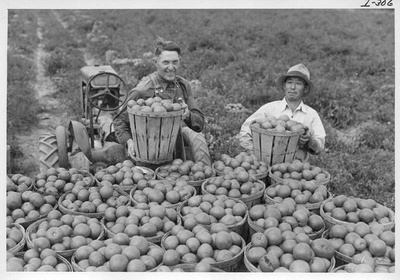
George Yamamoto. Photographer: Iwasaki, Hikaru -- Newtown, Pennsylvania. 8/?/44 National Archives photo. WRA no. I-306
There is no sense of irony behind the beaming smile of Mrs. John M. Sakai, shown holding up her husband’s picture in one hand and the Purple Heart medal he won in battle in Italy in the other. She is quoted as saying she is “proud that he is an American fighting for America,” and adding, “I also know my mother-in-law in the Gila River Relocation Center is just as proud.”
Despite the transparent agenda of these relentlessly and at times absurdly cheerful photos, Iwasaki told Hirayabayashi, who interviewed the photographer, now in his eighties, that he does not remember any overt censorship. Instead, the photographer attributed the upbeat nature of his WRAPS work to his youthful optimism, and his own successful experience of leaving camp early and finding fulfilling work with a bureaucratic arm of the government.
Hirayabayashi acknowledges that “critics might fault [Iwasaki] for not assertively seeking out cases that might damage WRA claims of resettlement success,” but defends the photographer, noting that those that did defy authority were not released from camp, and that prisoners like Iwasaki who were released early were the most capable and likely to succeed.”
In the final, most powerful section of his book, Hirabayashi tells readers that there is a way to reclaim these photographs, to shake off their original purpose as propaganda and view them in a more positive or honest light. “There is no reason the photos cannot be appropriated and redeployed for new purposes and with new visions in mind,” he writes.
To illustrate what he means Hirayabayashi selects a handful of the 1,300 Iwasaki photos (available online at JARDA , the Japanese American Relocation Digital Archive) that assert the humanity, resourcefulness and perseverance of the imprisoned, including a touching close-up of handmade zori (straw sandals) and geta (raised wooden sandals), which prisoners made out of scavenged materials. The traditional footwear was not only functional, it was a reminder and a connection to the prisoners’ homeland. There is a beautiful wood carving of a mother hawk attending to her chicks, and another of creatively carved wood nameplates that were hung outside barracks, all beautiful examples of native Japanese crafts.
Hirabayashi also counters the image of all resettlers as upwardly mobile professionals or highly respected laborers by poring through WRA archives and uncovering photographs that depict another side to the story: a desolate, Burbank, Calif. trailer park and housing project where Japanese Americans were temporarily resettled, squalid quarters in rural Colorado and elsewhere that Hirabayashi writes were “hardly different from those found in the camps.”
Japanese American Resettlement Through the Lens ends on a poignant note, with a photograph of a group of elderly Issei at a nursing home in San Francisco. The five men, looking haggard but stoic, pose with a nurse in uniform. One is in a wheelchair, one on crutches. Hirabayashi recalls his own, early, memories of his grandfather’s nursing home for elderly Japanese American resettlers in Spokane, Wash. “The plight of these Issei—single, elderly, infirm, poor—is something that I have not found discussed in any detail in the official WRA, or even in the scholarly literature,” Hirabayashi writes. This single Iwasaki photo, he adds, “has to represent the thousands of Issei whose lives were ruined by federal policies and who did not have the energy or the resources to recover after they were released from camp.”
*This article was originally published on Nancy Matsumoto’s blog: Walking and Talking.
*Read Lane Hirabayashi’s Discover Nikkei article, Japanese American Resettlement: Through the Lens, (posted on February 22, 2007) describing his book while it was still in development.
© 2009 Nancy Matsumoto


